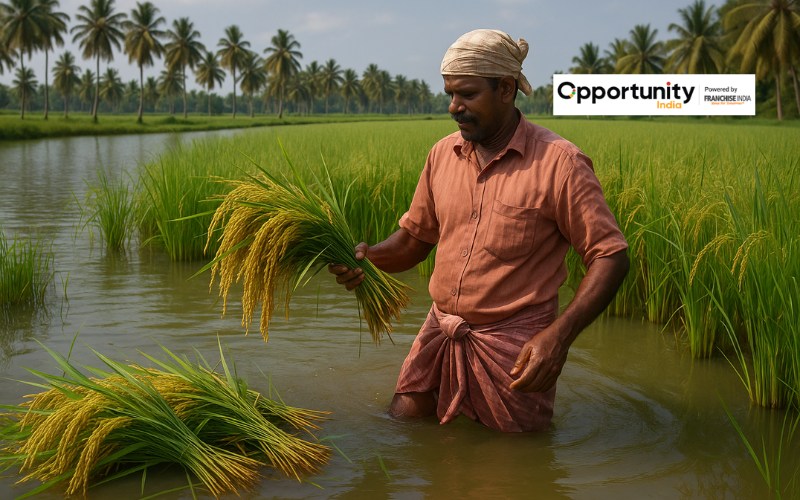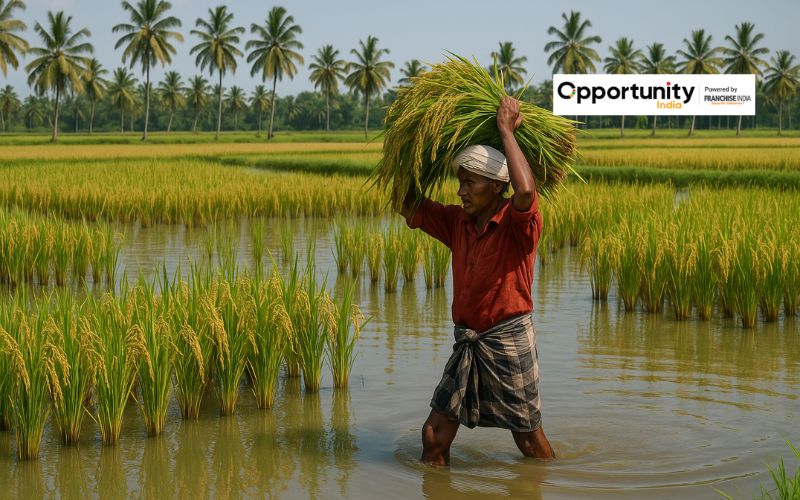
Consider a rice crop that may double your income with prawns, loves seawater, grows well in flooded fields, and requires no chemical fertilizers. Does it sound too good to be true? Presenting Pokkali rice, one of India's most sustainable farming practices and the renowned saline-resistant rice from Kerala. Pokkali rice farming may be your golden grain if you're searching for a distinctive, environmentally responsible, and profitable farming venture. Let's explore what makes it unique and how you may make it into a profitable business.
What Exactly is Pokkali Rice?
One of the most intriguing of India's many traditional and indigenous crops is Pokkali rice, a special type that can withstand seawater and is mainly planted along Kerala's coast. Pokkali rice cultivation is becoming more well-known as a traditional method and a profitable economic venture due to the growing interest in organic and climate-resilient farming.
Pokkali rice cultivation is a distinctive and age-old farming method found in Kerala's coastal districts. India is a land rich in agricultural diversity. Growing a crop is only one aspect of this symbiotic agro-ecosystem, which combines aquaculture, mainly fish and prawns, with rice farming in an amazing seasonal rotation.
Also Read: Goat Farming Business Plan: Key Steps
In Kerala's Kochi-Alleppey belt, particularly in flood-prone coastal areas, the traditional rice variety known as pokkali (often written pokali) is grown. This tall-growing, one-season rice type grows well in saline water-flooded fields, an environment that is unsuitable for most other crops.

Why Start a Pokkali Rice Farming Business?
The unique qualities of Pokkali are what really set it apart:
- Exceptional Salt Tolerance: Pokkali's distinctive quality is its extraordinary salt tolerance. Due to its ability to flourish in extremely salinized environments, it is extremely resistant to the entry of saltwater and rising sea levels, two important issues in coastal areas brought on by climate change.
- Flood Resistance: Pokkali plants can endure extended periods of immersion during intense monsoon rains and floods because of their remarkable height (up to 1.5 to 2 meters).
- Sustainable and Organic: Organic farming practices are essential to the Pokkali system. There is no usage of chemical pesticides or fertilizers.
- Medicinal and Nutritional Value: Pokkali rice is a great source of iron, fiber, vital minerals, and antioxidants, particularly anthocyanins. It is said to have therapeutic qualities that increase endurance and have a low glycemic index, making it appropriate for diabetics.
- Unique Flavor and Texture: It is highly valued for its distinct earthy flavor and tough texture, which makes it a popular ingredient in gourmet cooking and among health-conscious consumers.
- Geographical Indication (GI) Tag: In 2008-2009, Pokkali rice was granted a Geographical Indication (GI) designation, which protected its traditional knowledge and identity while acknowledging its exceptional quality and place of origin.
Also Read: How to Start an Import/Export Business?
The Business Potential of Pokkali Rice Farming
The area used for Pokkali cultivation has drastically decreased over the past few decades despite its many benefits because of several difficulties. Nonetheless, there is an increase in interest in this unusual crop due to:
- Growing Demand for Healthy and Organic Food: People are looking for more natural, chemical-free, and nutrient-dense food products.
- Climate Change Resilience: Pokkali and other crops that can tolerate severe weather and increasing salt are becoming increasingly valued as worries about climate change grow.
- Export Potential: Pokkali rice has a significant potential for export due to its distinctive qualities and organic status.
- Profitability of Integrated Farming: Compared to monoculture, the system as a whole is more profitable when rice and aquaculture are combined, since they provide a variety of revenue streams. According to studies, Pokkali-prawn integrated systems can produce net returns that are noticeably higher than those of semi-intensive prawn farming or even solitary rice growing.
Step-by-Step Guide to Start Pokkali Rice Farming
Let's explore each step of the Pokkali rice cultivation process, from choosing the land to selling it.
Land Selection and Preparation
- Pick backwater areas or low-lying, saline-prone coastal terrain.
- Fields need to be embanked to regulate water inflow.
- Seeds are dispersed straight into standing water in traditional Pokkali fields rather than being plowed.
Tip: If you're just starting, get in touch with a nearby Pokkali farming cooperative or seek advice from Kerala Agricultural University (KAU).
Also Read: 9 Profitable Pet Business Ideas
Choosing and Planting Seeds
- Use Pokkali seeds that have been certified by nearby cooperatives or agricultural organizations.
- In June and July, right before the monsoon, seeds are sown.
- The most popular approach is to broadcast seeds straight onto fields.
Seed Rate:
- Around 60–70 kg per hectare.

Crop Management
- There is no use of chemical pesticides or fertilizers.
- Fields can be manually weeded or naturally repressed by the depth of the water.
- As an organic system, the waste from fish and prawns enhances the soil during the shrimp farming cycle, feeding the next crop.
- Minimal disease and pests because of the saline water. If necessary, apply neem-based sprays.
Harvesting
- Harvested in October-November.
- Grain quality depends on drying, and harvesting by hand is common.
- The average yield is between 2 and 2.5 tons per hectare, which is little less than hybrid varieties but compensated for by premium pricing.
Also Read: How to Start a Tea Business in India?
Marketing
- For efficient branding, make use of the GI tag and Pokkali rice's organic, healthful, and climate-resilient qualities. Its market appeal can be raised by attractive packaging.
- Market Channels:
- Direct sales: online marketplaces, neighborhood shops, and farmers' markets.
- Supermarkets and organic food stores: These serve health-conscious customers.
- Export: Look into export prospects to nations where specialized grains are in high demand.
- Chefs and eateries: Work together with businesses that value distinctive, classic ingredients.
Investment Breakdown for Pokkali Rice Farming
Here’s an approximate breakdown of the cost and income for 1 hectare of Pokkali rice farming:
Initial Setup Costs (One-time):
| Component | Cost (INR) |
|---|---|
| Land embankments & bunds | ₹20,000 |
| Water channels/sluice gate (if needed) | ₹10,000 |
| Tools & equipment | ₹5,000 |
| Total Setup Cost | ₹35,000 |
Also Read: How to Start a Banana Farming Business?
Key Considerations Before Investing
- Water Salinity and Land Suitability: The most important consideration is whether your property is suited for growing pokkali. This type of rice grows well on low-lying, salty soil, which is typically found close to backwater or coastal areas. Pokkali may not work properly if your land does not naturally flood or have brackish water during the monsoon. It is perfect for regions where salinity causes traditional crops to fail.
- Seasonal Limitations: Pokkali is a crop that is grown only once a year, usually from June to November. This implies that there will only be one rice harvest annually.
- Labour and Traditional Knowledge: Pokkali cultivation is mostly dependent on manual labor and ancient methods, particularly for planting and harvesting, in contrast to contemporary mechanical farming. To get started correctly, you might need to talk with seasoned Pokkali farmers or recruit knowledgeable local laborers.
- Obtaining Real Seeds and Assistance: It's crucial to obtain genuine Pokkali seeds and technological assistance. These are typically offered by Krishi Vigyan Kendras, co-operative societies, or Kerala Agricultural University. Make sure you have access to trustworthy seed suppliers and knowledgeable guidance if you're not in Kerala.
- Branding and Market Access: Pokkali rice has a specialized market, mostly among consumers of organic food, Ayurvedic clinics, and urban health-conscious customers. Whether using internet platforms, direct-to-consumer sales, or local organic stores, you'll need a clear branding and marketing approach to turn a profit.
Pokkali rice farming is definitely something you should think about if you live near the coast, have property that is prone to salinity, or just want to experiment with sustainable farming in a novel way. It offers you a dual-income strategy with shrimp and rice, and is low risk and high value. Additionally, you're supporting environmentally sustainable farming practices and the rebirth of heritage crops.

